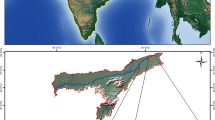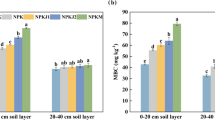Abstract
The objective of the present study was to evince the long-term changes after natural revegetation and experimental revegetation of the coal mine spoils with respect to total plant biomass, available plant nutrients, nitrogen transformation and microbial biomass N (MBN) in dry tropical environment of India. Total plant biomass (above- and below-ground), plant available nitrogen, soil nitrogen mineralization and microbial biomass N (MBN) were studied for 2 years in 5 and 10 years old naturally vegetated and revegetated coal mine spoils, and dry tropical forest ecosystem of India. In forest ecosystem, the above ground biomass values ranged from 3,520 to 3,630 kg ha−1 and belowground from 6,280 to 6,560 kg ha−1. Plant available nitrogen ranged from 16.76 to 23.21 μg g−1, net N-mineralization from 9.8 to 48.53 μg g−1 month−1 and MBN from 26.4 to 80.02 μg g−1. In naturally revegetated mine spoil, the above ground biomass values ranged from 1,036 to 1,380 kg ha−1 and belowground from 2,538 to 3,380 kg ha−1. Plant available nitrogen ranged from 7.33–17.14 μg g−1, net N-mineralization from 3.1 to 12.46 μg g−1 month−1 and MBN from 14.2 to 35.44 μg g−1. In revegetated mine spoil, the above ground biomass values ranged from 1,224 to 1,678 kg ha−1 and belowground from 2,870 to 4,130 kg ha−1. Plant available nitrogen ranged from 9.4 to 18.83 μg g−1, net N-mineralization from 4.2 to 16.2 μg g−1 month−1 and MBN from 21.6 to 42.6 μg g−1. The mean plant biomass values in 5 and 10 years mine spoils was lower compared to forest ecosystem by 2.5 and 2 times, respectively. N-mineralization value in 5 year mine spoil was 3.5 times lower and in 10 years mine spoil 2 times lower compared to forest ecosystem. The MBN value was about 2 times lower in both 5 and 10 year mine spoils compared to native forest. MBN was positively related to the re-vegetation age of the mine spoil.
Similar content being viewed by others
References
Ashby, W. C. (1987). Forests. In W. R. Jordan, M. E. Gilpin, & J. D. Aber (Eds.) Restoration ecology: A synthetic approach to ecological research. Cambridge, UK: Cambridge University Press.
Bardgett, R. D., Streeter, T. C., Cole, L., & Hartley, I. R. (2002). Linkages between soil biota, nitrogen availability, and plant nitrogen uptake in a mountain ecosystem in the Scottish highlands. Applied Soil Ecology, 19, 121–134.
Bauer, A., & Black, A. L. (1981). Soil carbon, nitrogen and bulk density comparison in two cropland tillage systems after 25 years and in virgin grasslands. Soil Science Society of American Journal, 45, 1166–1170.
Bernhard, R. F. (1988). Soil nitrogen mineralization under a Eucalyptus plantation and a natural Acacia forest in Senegal. Forest Ecology And Management, 23(4), 233–244.
Birch, H. F. (1958). The effect of soil drying on decomposition and nitrogen availability. Plant and Soil, 10, 9–31.
Birch, H. F. (1960). Nitrification of soils after different periods of dryness. Plant and Soil, 12, 81–96.
Bradshaw, A. D. (1987). The reclamation of derelict land and the ecology of ecosystems. In W. R. Jordan, M. E. Gilpin, & J. D. Aber (Eds.) Restoration ecology: A synthetic approach to ecological research (pp. 53–74). Cambridge, UK: Cambridge University Press.
Brady, N. C., & Weil, R. R. (2002). The nature and properties of soils (13th ed.). Upper Saddle River, NJ: Prentice Hall.
Brookes, P. C., Landman, A., Pruden, G., & Jenkinson, D. S. (1985). Chloroform fumigation and release of soil N: A rapid direct extraction method to measure microbial biomass N in soil. Soil Biology & Biochemistry, 17, 837–842.
Cassmann, K. G., & Munns, D. N. (1980). Nitrogen mineralization as affected by soil moisture, temperature and depth. Soil Science Society of American Journal, 44, 1233–1237.
Chaulya, S. K., Singh, R. S., Chakraborty, M. K., & Tewary, B. K. (2000). Bioreclamation of coal mine overburden dumps in India. Land Contamination & Reclamation, 8(3), 189–199.
Chen, C. R., Xu, Z. H., Blumfield, T. J., & Hughes, J. M. (2003). Soil microbial biomass during the early establishment of hoop pine plantation: Seasonal variation and impacts of site preparation. Forest Ecology and Management, 186(1–3), 213–225.
Davidson, J. M., Fenton, G., & Pinson, D. I. (1967). Changes in organic matter and bulk density with depth under two cropping system. Agronomy Journal, 59, 375–378.
Dobson, A. P., Bradshaw, A. D., & Baker, A. G. M. (1997). Hopes for the future: Restoration ecology and conservation biology. Science, 277, 515–522.
Eno, C. F. (1960). Nitrate production in the field by incubating the soil in polyethylene bags. Soil Science Society of America Proceedings, 24, 277–279.
Fisher, R. F. (1990) Amelioration of soils by trees. In S. P. Gessel, D. S. Lacate, G. F. Weetman, & R. F. Powers (Eds.), Sustained productivity of forest soils. Proc. North American For. Soils Conf., 7th. Vancouver, B.C., 24–28 July, 1988, Univ. British Columbia, Faculty of For. Publ. Vancouver, B.C. 525 p.
Harris, J. A. (2003). Measurements of the soil microbial community for estimating the success of restoration. European Journal of Soil Science, 54, 801–808.
Jackson, M. L. (1958). Soil chemical analysis. Englewood Cliffs: Prentice Hall.
Jha, A. K., & Singh, J. S. (1992). Rehabilitation of mine spoils; Restoration of degraded land: Concepts and strategies, pp. 211–253.
Kaye, , & Hart, (1998). Ecological restoration alters nitrogen transformations in a Ponderosa pine bunchgrass ecosystem. Ecological Applications, 8(4), 1052–1060.
Lodge, D. J., McDowell, W. H., & McSwiney, C. P. (1994). The importance of nutrient pulses in tropical forest. Trends in Ecology E, 9, 384–387.
Macyk, T. M. (2002). Thirty years of reclamation research in the Alpine and Sub Alpine regions near Grande Cache, Alberta. In Proceedings of the 26th annual British Columbia mine reclamation symposium in Dawson Creek, BC.
Magurran, A. E. (1988). Ecological diversity and its measurement. Princeton, NJ: Princeton University Press.
Maly, S., Tarapatka, B., & Krtkova, M. (2002). Seasonal variability in soil N mineralization and nitrification as influenced by N-fertilization. Rostlinna Výobra, 9, 389–396.
Mehta, N. C., Leg, J. O., Goring, C. A. I., & Black, C. A. (1954). Determination of organic phosphorus in soil. I. Extraction method. Proceedings of the Soil Science Society of America, 18, 443–449.
Melillo, J. M. (1981). Nitrogen cycling in deciduous forests. In F. E. Clark, & T. Rosswall (Eds.) Terrestrial nitrogen cycles: Processes, ecosystem strategies, and management impacts (pp. 427–442). Stockholm: Ecological Bulletins.
Montagnini, F., Haines, B. L., Swank, W. T., & Waide, J. B. (1990). Nitrification in undisturbed mixed hardwoods and manipulated forests in the southern Appalachian mountains of North Carolina, U.S.A. Canadian Journal of Forest Research, 19, 1226–1234.
Pastor, J., Aber, J. D., McClaugherty, C. A., & Melillo, J. M. (1984). Above ground production and N and P cycling along a nitrogen mineralization gradient on Blackhawk Island, Wisconsin. Ecology, 65, 256–268.
Paul, E. A., & Clarke, F. E. (1996). Soil microbiology and biochemistry. San Diego: Academic 368 pp.
Perakis, S. S., & Hedin, L. O. (2002). Nitrogen loss from unpolluted South American forest mainly via dissolved organic compounds. Nature, 415, 416–419.
Piper, C. S. (1994). Soil and plant analysis. Adelaide: Inter Science.
Raghubanshi, A. S., Srivastava, S. C., Singh, R. S., & Singh, J. S. (1990). Nutrient release in leaf litter. Nature, 346, 227.
Reeder, J. D., & Sabey, B. (1987). Nitrogen. In R. D. Williams, & G. E. Schuman (Eds.) Reclaiming mine soils and overburden in the Western United States. Analytic parameters and procedures. Ankeny, IA: SCSA.
Rhoades, J. D. (2001). http://www..netl.doe.gov/publications/proceedings/01/carbon_seq_terr/graves.pdf.
Roberts, J. A., Daniels, W. L., Bell, J. C., & Martens, D. C. (1988). Tall fescue production and nutrient status on Southwest Virginia mine soils. Journal of Environmental Quality, 17, 55–62.
Ross, D. J. (1987). Microbial biomass estimated by the fumigation–incubation procedure: Seasonal fluctuations and influence of soil moisture content. Soil Biology and Biochemistry, 19, 397–404.
Roy, A., & Singh, K. P. (2003). Dynamics of microbial biomass and nitrogen supply during primary succession on blast furnace slag dumps in dry tropics. Soil Biology and Biochemistry, 35(1), 365–372.
Růžek, L., Voříšek, K., & Sixta, J. (2001). Microbial biomass-C in reclaimed soil of the Rhineland (Germany) and the North Bohemian lignite mining areas (Czech Republic): Measured and predicted values. Restoration Ecology, 9(4), 370–377.
Sanchez, P. A. (1976). Properties and management of soils in the tropics. New York: Wiley.
Sanchez, P. A., Palm, C. A., Davey, C. B., Szott, L. T., & Russell, C. E. (1985). In M. G. R. Cannel, & J. E. Jackson (Eds.) Attributes of trees as crop plants pp. 327–350. Abbots Ripton, Huntingdon: Institute of Terrestrial Ecology.
Schimel, D. S., & Parton, A. (1986). Carbon and nitrogen turnover in adjacent grassland and cropland ecosystems. Biogeochemistry, 2, 345–357.
Sharma, D., & Sunderraj, S. F. W. (2005). Species selection for improving disturbed habitats in Western India. Current Science, 88(3), 462–467.
Singh, J. S. (1990). http://www.envfor.nic.in/divisions/re/ta5p8.html.
Singh, A. (2006). Herbaceous species composition of an age series of naturally revegetated coal mine spoils on Singrauli Coalfields, India. Journal of the Indian Institute of Science, 86, 76–80.
Singh, A., & Singh, J. S. (2001). Comparative growth behaviour and leaf nutrient status of native tree planted on mine spoil with and without nutrient amendment. Annals of Botany, 87, 777–787.
Singh, A. N., & Singh, J. S. (2006). Experiments on ecological restoration of coal mine spoil using native trees in a dry tropical environment, India: A synthesis. New Forests, 31, 25–39.
Singh, R. S., Chaulya, S. K, Tewary, B. K., & Dhar, B. B. (1996). Restoration of a coal-mine overburden dumps – A case study. Coal International, March, 80–83.
Singh, R. S., Raghubanshi, A. S., & Singh, J. S. (1991). Nitrogen mineralization in dry tropical savanna: Effects of burning and grazing. Soil Biology & Biochemistry, 23(3), 269–273.
Singh, A. N., Raghubanshi, A. S., & Singh, J. S. (2002). Plantations as a tool for mine spoil restoration. Current Science, 82(12), 1436–1441.
Singh, J. S., Raghubanshi, A. S., Singh, R. S., & Srivastava, S. C. (1989). Microbial biomass acts as a source of plant nutrients in dry tropical forest and savanna. Nature, 338, 499–500.
Snedecor, G. W., & Cochran, W. G. (1967). Statistical methods p. 593. New Delhi: Oxford & IBH Publishing Co.
Society for Ecological Restoration (2002). The SER primer on ecological restoration, http://www.ser.org/.
Sorenson, L. J. (1974). Rate of decomposition of organic matter in soil as influenced by repeated air drying–rewetting and repeated additions of organic matter. Soil Biology and Biochemistry, 6, 287–292.
Sparling, G. P., Milne, J. G., & Vincent, K. W. (1987). Effect of moisture regime on the microbial contribution to Olsen P values. New Zealand Journal of Agricultural Research, 30, 79–84.
SPSS. 1997. SPSS base 7.5 application guide. Chicago: SPSS Inc.
Srivastava, S. C., & Singh, J. S. (1989). Effect of cultivation on microbial carbon and nitrogen in dry tropical forest soil. Biology and Fertility of Soils, 8, 343–348.
Srivastava, S. C., & Singh, J. S. (1991). Microbial C, N and P in dry tropical forest soil: Effects of alternate land uses and nutrient flux. Soil biology and Biochemistry, 23(2), 117–124.
Torbert, J. L., Burger, J. A., & Daniels, W. L. (1993). Pine growth variation associated with overburden rock type on a reclaimed surface mine in Virginia. Journal of Environmental Quality, 19, 88–92.
Voroney, R. P., Van Veen, J. A., & Paul, E. A. (1981). Organic C dynamics in grassland soils. II. Model validation and simulation of the long-term effects of cultivation and rainfall erosion. Canadian Journal of Soil Science, 61, 211–224.
Wetzel, R. G., & Likens, G. E. (1979). Limnological analyses, 357. Philadelphia: W.B. Saunders Co.
Wild, A. (1987). Soils and the environment – An introduction. Cambridge, Low Price Edition, 287p.
Author information
Authors and Affiliations
Corresponding author
Rights and permissions
About this article
Cite this article
Tripathi, N., Singh, R.S. Ecological restoration of mined-out areas of dry tropical environment, India. Environ Monit Assess 146, 325–337 (2008). https://doi.org/10.1007/s10661-007-0083-7
Received:
Accepted:
Published:
Issue Date:
DOI: https://doi.org/10.1007/s10661-007-0083-7




